Persian-Arabian Wainscot in Glazed Clay
From the 16th century Mosque of Ibrahim Aga at Cairo "exemplifying a mixture of the Persian and Arabian styles, inasmuch as the predominance of vegetable ornamentation directly points to Persian influence".

Arabian Ornaments in Wood and Metal
Surrounding an escutcheon rendered in bronze are door panels and window screening lattices in wood and bronze door fittings
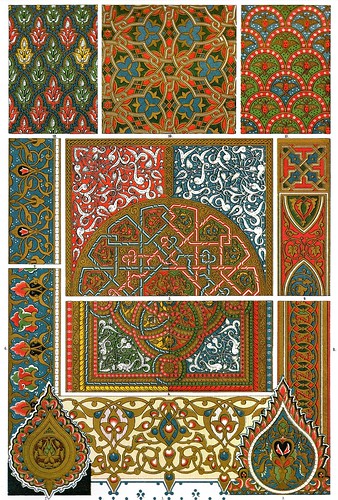
Arabian Illumination of Manuscripts
"Arabian artists show special skill in surface decoration. Scroll work, rigidly idealised, alternates with geometrical figures, or else the arabesque ornament fills the compartments formed by the lines and bands. In this manner whole pages are painted in many Koran manuscripts. [..] The writing itself is in most cases bordered and surrounded with rosettes and friezes, which are filled in with ever new combinations of lines and foliage."
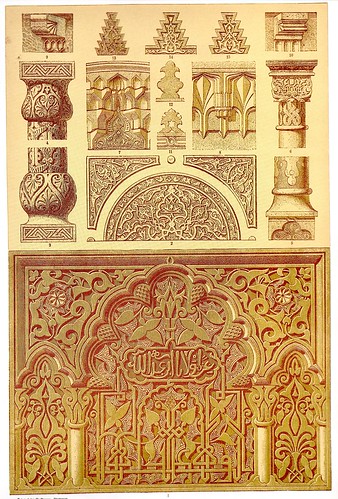
Arabian-Moresque Architectonic Ornaments
Pinnacles, panels, decoration, stalactites and corbels from the Alhambra in Spain and Cairo. "The columns at first followed Egyptian and Byzantine examples or were, in fact, composed of parts of Greek or Roman columns; later on however (since about the 12th century) they were formed in a style of their own, the capital consisting mainly of a cube decorated with foliage and scroll work."
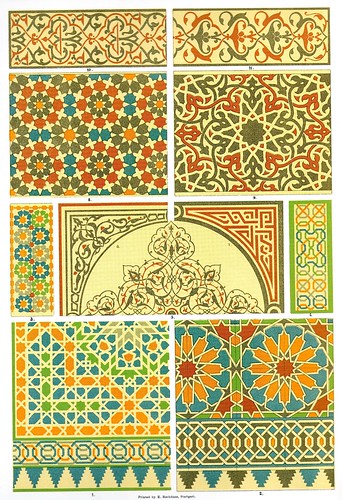
Arabian-Moresque Mosaic Work and Glazed Clay Work
Clay and marble wainscottings from the Alhambra, Cairo and Damasacus. "Arabian and Moorish mosaics are made partly of small pieces of coloured marble, partly of small clay plates, painted and glazed. Sometimes the designs are cut into the marble plates and the deepenings filled with coloured cement (stucco)."
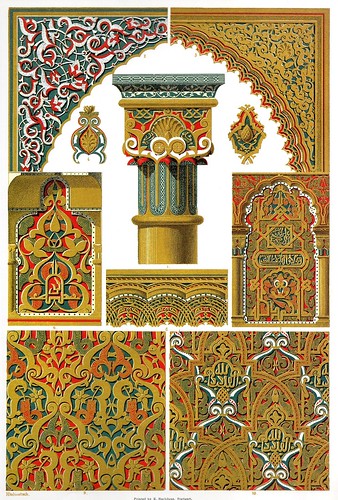
Moresque Architectonic Ornaments
(all details from the Alhambra) "Spain is the country, where the Islamitic art found its purest and most beautiful development in the buildings of the Moorish kings, for instance, in the palace of the Alhambra near Granada (13th and 14th century). Especially with the Moors, Mahomaden ornamentation reached its culminating point. [..] The characteristics of Arabian ornamentation are identical with the Moorish, but it may be added, that the former is neither so happy in the distribution of the ornament over the surface, nor so varied as the latter. The Moorish artists knew how to produce wonderful effects by artfully interlacing and twisting the geometrical patterns and arabesque ornaments; for here they could give full play, so to speak, to their richly gifted imagination."

Turkish Architectonic Ornaments in Glazed Clay
From Mosques and tombs at Brussa and Mouradieh. The Turkish-specific system of ornamentation really began in the 15th century, derived at first from Byzantine and later, Persian and Arabian styles. Scroll work often leaves comparatively large areas of uncovered background and artists employed ingenious interlacements of several systems of lines. The author talks about the abundance of the "re-entering angle" seen in leaves and scrolls.

Celtic Illumination of Manuscripts
Pattern examples from the 7th to 11th centuries. "Among the Celtic populations of Ireland there was already in very early times an original style of ornament developed, the commencement of which no doubt goes far back to the days when heathenism still prevailed in that island. [..] For Celtic interlacing work, either filling up the spare surfaces of the letters or bordering the separate pages, the limbs or bodies of snakes, birds, dogs and fantastical animals were employed. Occasionally the human figure occurs, whereas the vegetable ornament is wholly wanting. Its introduction first dates from the 9th century, and after weak commencements, it spreads more and more, next the ribbon ornament, under the influence of the Romanesque style."
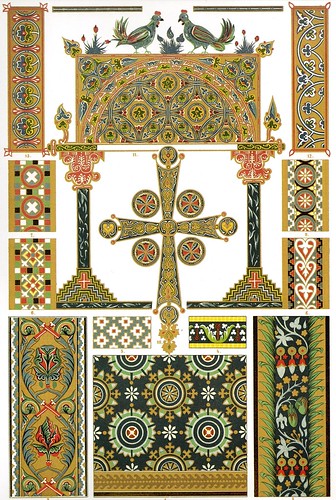
Byzantine Glass-Mosaic, Coloured Enamel and Illumination
Details from Ravenna, Venice, Constantinople, Comburg and manuscript details from repositories in St Petersburg and Moscow.
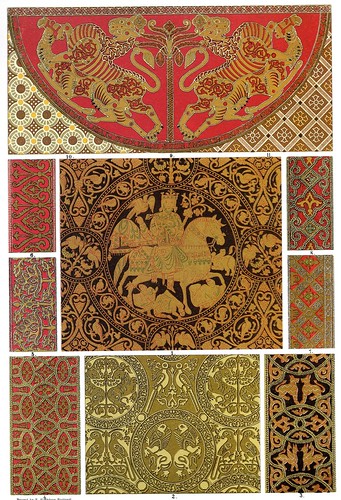
Byzantine Weaving and Embroidery
"Sicilian articles exhibiting clearly the influence of Arabian ornamentation, without denying Byzantine forms. In these woven fabrics the ornament is always treated as surface decoration. The plants and animals which we see applied, do not exactly intimate nature, but are more or less idealised."

Middle-Ages Enamel and Illumination of Manuscripts
"The Romanesque ornament found its freest display in the illumination of manuscripts, where particularly the large initials were magnificently treated. Especially animals were here combined with scroll work in the most strange arabesque-like representations. The ground of the paintings in the earlier times was gold, later on many-coloured. In the art of enamelling, which had been transferred from Byzantium to Germany, the German artists attained a high point of perfection; only they took for their metal-ground copper-plates instead of the expensive gold-plates, and instead of email cloisonné* they employed champlevé* work which then spread also in France and made the manufacturies of Limoges far and wide renowned."
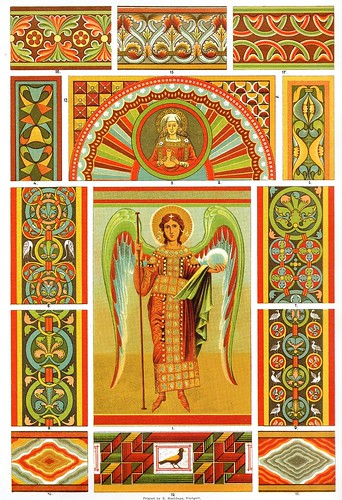
Middle-Ages Wall Painting
"From sites in Italy and Germany. "The colours used in wall painting are cheerful and of great variety. The human figures do not exhibit the same rigidity of old age as the contemporary Byzantine, but show a freer and more youthful movement. The folds of the garments following pretty closely the forms of the body, are much better modelled than, for instance, in the Byzantine images. As regards the ornament, all the pecularities of the Romanesque style are likewise applicable to it. Frequent use is made of the circle or parts or a circle."

Middle-Ages Stained Glass
Examples from Troyes, St Denis, Angers, Bourges, Paris, Strasbourg and Rome. The author's comments make little sense other than to note that glass painting began around the end of the 10th century.

Middle-Ages Stone-Mosaic
Details shown are derived from mosaic floors, engraved stone flags and enamelled clay tiles in France, Germany and England. "Where stones of various colours for an artistic floor-incrustation were not available, it plainly was expedient, to use small clay-plates or engraved stone-flags for adorning the floors". In the period of dominance by the Romanesque style, the stone flags had decorative designs rendered in coloured cement (similar to Arabian ornamentation) and often fired with a transparent glazing. Designs in mosaic compositions were almost exclusively geometric patterns; in other types of floor incrustations, human figures, plants and animals were the dominat theme. "Among the plants the lily is most variously idealised, and as in glass-painting, the oak and wine leaves are everywhere repeated."

Middle-Ages Wood Mosaic
Designs come from church reading desks, vestry doors and stalls in Venice, Verona and Ulm. "It was no great step from adorning walls and floors with variously coloured materials to a similar decoration of wooden objects. Here however, ornamentation was somewhat limited by the nature of the wood; accordingly vegetable and figural representations are seldom found, at least in the Gothic style, whereas we meet most frequently with band and line ornament, in conjunction with a kind of mosaic work, consisting of small pieces of wood being arranged as stars etc."
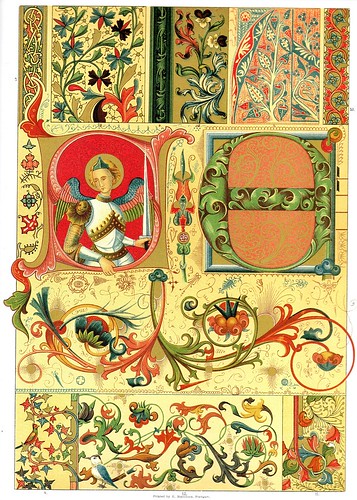
Middle-Ages Illumination of Manuscripts
"In the illumination of manuscripts the livelier forms of the ornament superseded slowly the round, surface-filling forms of the Romanesque style. The flowers were often idealised, also some direct from nature and the styles were sometimes combined, especially in the later Gothic time. Characteristically of this time is a deep shading, as well as the use of half tones, and the laying on of lights." [!?]

Middle-Ages Ceiling and Wall Painting
Details from churches in Germany (most) and France. "The further progress in wall-painting in the Gothic period was somewhat impeded by the want of wall surfaces suitable to the reception of larger pictures, whereas sufficient opportunity was given for ornamentation. The occurring figures were influenced by the upward direction and frequent narrowness of the space at disposal, wherefore they exhibit not seldom a too slender appearance."
These are further scans from 'Der Ornamentenschatz' (1887) by Heinrich Dolmetsch, first published in English in 1898 as 'The Treasury of Ornament'.
See also: The Treasury of Ornament I.
The Owen Jones classic of this genre, 'The Grammar of Ornament', was published in 1856 and is available from the Digital Library for the Decorative Arts and Material Culture at the University of Wisconsin. I haven't (yet) compared the two works to get a sense of the degree of originality in the Dolmetsch book. {Next up: the Renaissance}
UPDATE: The Treasury of Ornament 3
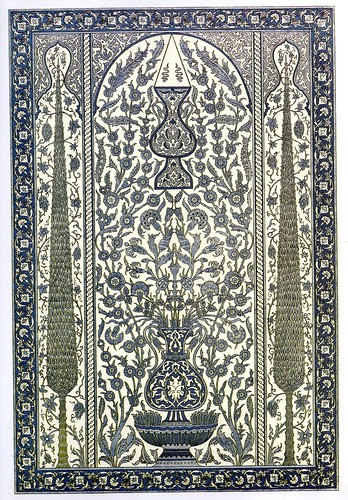



















8 comments :
amazing
I've posted a chunk of Grammar of Ornament. It is different in quite a few ways, although there does seem to be some overlap. Here are links...
Part One
Part Two
Part Three
Part Four
Enjoy!
Steve Worth
ASIFA-Hollywood Animation Archive
Thank you! What a fabulous collection of images. Love them....yum.
Just love this blog! :)
These blew my mind. Thank-you so much for sharing your collections with us. They always feed my creativity!
cuanta belleza !
http://ecai.org/sasanianweb/sites/Ctesiphon.html
Please read more about the origin of ornamentations in near east
Thanks for that link Mansoor eqdam.
Post a Comment
Comments are all moderated so don't waste your time spamming: they will never show up.
If you include ANY links that aren't pertinent to the blog post or discussion they will be deleted and a rash will break out in your underwear.
Also: please play the ball and not the person.
Note: only a member of this blog may post a comment.